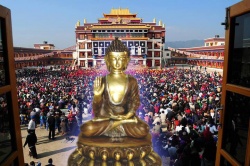Śvētāmbara
The Śvētāmbara (/ʃwɛˈtʌmbərə/; Sanskrit: श्वेतांबर or श्वेतपट śvētapaṭa; also spelled Svetambar, Shvetambara, Shvetambar or Swetambar) is one of the two main sects of Jainism, the other being the Digambara. Śvētāmbara "white-clad" is a term describing its ascetics' practice of wearing white clothes, which sets it apart from the Digambara "sky-clad" Jainas, whose ascetic practitioners go naked. Śvētāmbaras, unlike Digambaras, do not believe that ascetics must practice nudity.
Śvētāmbaras also believe that women are able to obtain moksha. Śvētāmbaras maintain that the 19th Tirthankara, Mallinath, was a woman. In 2006, there were 2,510 monks and 10,228 nuns in the Śvētāmbara sects while there were 548 Digambara monks and 527 Digambara nuns.
The Śvētāmbara tradition follows the lineage of Acharya Sthulibhadra Suri. The Kalpa Sūtra mentions some of the lineages in ancient times. The Śvētāmbara monastic orders are branches of the Vrahada Order, which was founded in 937 AD. The most prominent among the classical orders today are the Kharatara (founded 1024 AD), the Tapa (founded 1228 AD) and the Tristutik.
A major dispute was initiated by Lonka Shaha, who started a movement opposed to idol worship in 1476. The Sthanakvasi and Terapanthi orders are branches of this movement.
Major reforms by Vijayananda Suri of the Tapa Order in 1880 led a movement to restore orders of wandering monks, which brought about the near-extinction of the Yati institutions. Acharya Rajendrasuri restored the shramana organization in the Tristutik Order.
Some Śvētāmbara monks and nuns cover their mouth with a white cloth or muhapatti to practise ahimsa even when they talk. By doing so they minimize the possibility of inhaling small organisms.
Denominations
The "Svetambar" got divided into different panths. First some saints left Svetambar to form Sthankvasi in 1474 AD,[citation needed] then in 1760 AD 13 Saints started their own panth called as "Terapanth" or "Deravasi".
So now at present there are 2 panths in "Shvetambar". The Sthankvasi believe in praying to Saints than to a stone in temple, the same philosophy is carried on by "Terapanth" or "Deravasi". Other difference between Deravasi Jains and Sthankvasi Jains is that the saints (monks) of Deravasi do not wear white cloth (white cloth called as Mupathi) near their mouth to cover it, they hold it in hand. While Sthankvasi Saints wear Mupathi through white cotton thread tied to their ears. They do not keep Idols in Worship place called Sthanak or Derasar. They pray and bow to Panch Mahamantar. While "Deravasi" people keep an idol of Tirthakar at their holy place called as "Derasar" and they worship them.
